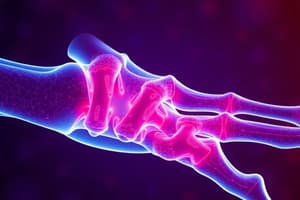Podcast
Questions and Answers
What happens to bone density when increased physical stress is applied to it?
What happens to bone density when increased physical stress is applied to it?
- Bone density decreases.
- Bone density remains unchanged.
- Bone density fluctuates without a trend.
- Bone density increases. (correct)
Which effect is demonstrated when pressure on a tissue generates a slight electric charge?
Which effect is demonstrated when pressure on a tissue generates a slight electric charge?
- Archimedes' principle.
- Piezo-electric effect. (correct)
- Thermal conductivity effect.
- Magnetic resonance effect.
What is the primary role of Wolff's Law in relation to bone?
What is the primary role of Wolff's Law in relation to bone?
- It describes how bone healing occurs.
- It dictates that bone adapts to the stresses placed on it. (correct)
- It explains calcium absorption in the digestive system.
- It determines the initial structure of a bone.
What occurs to bone in response to decreased physical stress?
What occurs to bone in response to decreased physical stress?
Where is calcium deposited during excessive stress on bones at the joint surface?
Where is calcium deposited during excessive stress on bones at the joint surface?
What is one outcome of applying excessive physical stress to a bone?
What is one outcome of applying excessive physical stress to a bone?
Flashcards
Wolff's Law
Wolff's Law
Bones adapt to the stress they experience. Increased stress leads to bone growth; decreased stress leads to bone loss.
Bone Stress
Bone Stress
Physical forces acting on a bone.
Bone Growth Response
Bone Growth Response
Bone's response to increased stress by adding bone matrix.
Bone Loss Response
Bone Loss Response
Signup and view all the flashcards
Piezoelectric Effect
Piezoelectric Effect
Signup and view all the flashcards
Bone Density Increase
Bone Density Increase
Signup and view all the flashcards
Study Notes
Wolff's Law
- Wolff's Law describes how bone adapts to stress.
- Increased physical stress on bone results in increased bone density (more bony matrix).
- Decreased physical stress on bone results in decreased density (less bony matrix).
Bone Structure
- Bones have an outer layer of compact (dense) bone and an inner layer of spongy (cancellous) bone.
- Long bones have an epiphysis at each end, a diaphysis (shaft) in the middle, articular cartilage at the ends and an epiphyseal line (or plate) between the two.
- Spongy bone is located in the interior of the bone, and the outer layer is called compact bone.
- Features in a long bone are the medullary cavity, nutrient foramen, endosteum, periosteum, and the epiphyseal line/plate.
Piezoelectric effect
- Pressure on bone creates an electrical charge (piezoelectric effect).
- Osteoblasts (bone building cells) are activated by this.
- Increased electrical charge encourages more bone growth in that specific area, and osteoclasts are unable to remove this bone.
- Calcium (Ca++) is then deposited in response and the bone grows denser.
Studying That Suits You
Use AI to generate personalized quizzes and flashcards to suit your learning preferences.




